The Golden Age by Tahmima Anam, due out in January from John Murray, promises to be a rich, interesting novel with the 1971 Bangladesh Liberation War as background. It is attracting positive press coverage already. The Guardian called her "a major new talent." Excerpt to appear in January's Granta. Wow!
http://books.guardian.co.uk/news/articles/0,,1957394,00.html
Wednesday, November 29, 2006
Sign Language (photos)
Thursday, November 23, 2006
In the Land of Cup and Lip: Becoming a Bangladeshi Again
[A slightly different version of this essay appears in The Daily Star Weekend Magazine today. Notes for non-Bengali readers follow the essay.]
After living 30 years abroad, I have returned to Bangladesh. I am re-learning how to live in my native land. While rediscovering many sights, sounds and tastes from my childhood, I am also evolving a new way of living that echoes the rhythm of life here.
Take the seasons for example. Sure, I knew Bangladesh has six, but over the years I had grown clueless about their bounties. Not any more. As Grishho (summer) approaches, all my thoughts turn to Rajshahi mangoes. Water covering miles of fields in Borsha (rainy season) does not unsettle me because in Hemonto (late autumn) I will see the same fields glowing golden with paddyfields. Shorot (early autumn) brings Shaplas of more colors than I had imagined. In Sheet (winter), during an orange-green sunset, I watch the fog roll into the tea garden hills. As Boshonto (spring) emerges from winter, bright orange Krishnochuras set the sky aflame.
I fathom nature's mysteries with patience, but man-made ones stump me. Why do rickshaws have two brake-handles but only one works? What are those towels on the back of officers' chairs for? Why is a job titled "Senior Assistant" when those words mean "Senior Junior?" Why is personal integrity so rare that we point out so-and-so is an "honest" officer as if they were a rare Doodhraj bird (paradise flycatcher)? When I need directions, why does one who does not know insist on being helpful and point me the wrong way? Why do cars blink hazard lights when they are crossing an intersection? And what is a "Gatelock" bus?
Of life's uncertainties, Shakespeare said, "Many a slip 'twixt cup and lip." Living in Bangladesh, the land of cup and lip, I must accord uncertainty its due stature. Making a weekend plan for a short trip out of town? A hartal strikes. Going to an important business meeting? Sorry, my counterpart's aunt died and he is absent from office. Flying overseas tomorrow? At 8pm the night before my travel agent carrying my ticket is stuck in traffic.
With growing uncertainty comes less privacy. At a government office a visitor inadvertently entertains us by discussing private business with the officer in front of five other visitors like me. Back in my own office, a one-on-one discussion regarding an employee's performance issues is interrupted several times as people walk in for various reasons.
I quickly learn to be mistrustful of unexpected privacy. Choosing to walk on the right side of a bridge because everyone else is on the left, I soon discover the reason for my privacy: this side harbors a hidden garbage dump emitting noxious stench.
Following other pedestrians’ footsteps, I compulsively avoid climbing pedestrian overpasses when crossing the road. If I need to cross the road, I will brave oncoming traffic, jump over traffic islands, and risk getting my jeans ripped by barbed wires placed precisely to discourage jaywalkers like me. That overpass is for sissies, not Real Bangladeshis.
Unexpected new words or phrases tell me that even the language has changed. Some, like Bhasha Shoinik referring to those who fought in the Language Movement of the 1950s and 60s, are powerful additions. Shopkeepers seeking class insist their goods, once shosta (cheap), are now shasroyee (inexpensive). But who let irritations like aalga pechail and kora mishTi into this sweet language of mine? Best of all, I hear villagers say Bangla to mean Bangladeshi (“He is a Bangla”), silencing the tedious "Bangladeshi" vs "Bengali" arguments.
Fears that dogged me during the early days of my return slowly recede. The risk of dengue from a mosquito bite sustained during the day no longer keeps me awake at night. Nor do I hunt down the blood-engorged mosquito to check for white stripes as I once did, because this knowledge is utterly useless a posteriori. Food adulteration, traffic accidents, pollution and noise - these are all reduced from unacceptable to mere nuisance.
While fears reduce, death becomes a bigger part of life. I find that we Bangladeshis have trouble letting go of our dead, starting with our two long gone political leaders who, after so many years, still tower over national politics. The newspapers are full of notices of not just some prominent person who recently passed away, but also of 10th, 15th or even the 20th anniversary of important peoples' death! Many of these influential people achieved much because of their focus on the present. Yet, here we are, harping on the past, invoking their memory for sentimental - or worse, manipulative - reasons.
In a bid to shake off morbid thoughts, I explore the parks and gardens. I observe the elegance of the Bulbuli as it weaves in and out of the flowers, and marvel at the resourceful Shalik consistently managing to find food on the roadside. I watch with suspense as a Cheel dives into the water to grab lunch, and my heart jumps with the Fingey as it flicks its long V-shaped tail swinging on electric wires and then swoosh! zips away. I feel – however fleetingly - the profundity of Jibananda Das's words:
"You all can go wherever you want
I will stay right here in Bangla".
The sweetest rewards come unexpectedly. Biting into a LoTkon fruit after thirty years, my mind is flooded with childhood memories, like Proust's character Swann experienced when he tasted a madeleine cookie in "Remembrance of Things Past."
I gauge my progress towards my goal during chance encounters with the locals. Like the time when I am bicycling through a village in Rupganj area. A boy, barely ten, stops me, points to a tall Kamranga tree full of ripe juicy fruit, and offers to climb it and pick some, free of charge. "Want to try it, sir, it is very sweet", he asks me. I had forgotten how unbelievably hospitable, friendly and generous Bangladeshi villagers are. I realize that attaining this level of being Bangladeshi will be tough.
[Notes for non-Bangladeshi readers:
1. Bangladesh has 6 seasons: Summer, Rainy Season, Early Fall, Late Fall, Winter and Spring. In Bengali these are Grishho, Borsha, Shorot, Hemonto, Sheet, Boshonto. The language is Bengali (aka Bangla.)
2. Rajshahi in northern Bangladesh is famous for its sweet mangoes.
3. Shapla, a water-lily, is the national flower of Bangladesh.
4. Bangladeshi rickshaws have two brake handles but only one is attached to a (front) brake. There is no brake at the rear.
5. A hartal is political protest that shuts down shops and most traffic for the day. Offices usually remain open.
6. The Language Movement, from the 1950s, was a people’s movement in Bangladesh (then East Pakistan) to promote Bengali and resist the adoption of Urdu (spoken only in West Pakistan) as the national language.
7. Aalga Pechail means “unnecessary complicated talk” and Kora Misti means “very sweet” (used by fruitsellers.)
8. Shalik, bulbul, fingey and cheel are birds of sturnidae, nightingale, drongo and kite families.
9. Jibananda Das, a Bengali poet, is best-known for his celebration of natural beauty of the region.
10. You can reach Rupganj in an hour of bicycling from Dhaka’s diplomatic zone.
11. Kamranga is starfruit. LoTkon is a local fruit, intensely tangy with a nice flavor.
After living 30 years abroad, I have returned to Bangladesh. I am re-learning how to live in my native land. While rediscovering many sights, sounds and tastes from my childhood, I am also evolving a new way of living that echoes the rhythm of life here.
Take the seasons for example. Sure, I knew Bangladesh has six, but over the years I had grown clueless about their bounties. Not any more. As Grishho (summer) approaches, all my thoughts turn to Rajshahi mangoes. Water covering miles of fields in Borsha (rainy season) does not unsettle me because in Hemonto (late autumn) I will see the same fields glowing golden with paddyfields. Shorot (early autumn) brings Shaplas of more colors than I had imagined. In Sheet (winter), during an orange-green sunset, I watch the fog roll into the tea garden hills. As Boshonto (spring) emerges from winter, bright orange Krishnochuras set the sky aflame.
I fathom nature's mysteries with patience, but man-made ones stump me. Why do rickshaws have two brake-handles but only one works? What are those towels on the back of officers' chairs for? Why is a job titled "Senior Assistant" when those words mean "Senior Junior?" Why is personal integrity so rare that we point out so-and-so is an "honest" officer as if they were a rare Doodhraj bird (paradise flycatcher)? When I need directions, why does one who does not know insist on being helpful and point me the wrong way? Why do cars blink hazard lights when they are crossing an intersection? And what is a "Gatelock" bus?
Of life's uncertainties, Shakespeare said, "Many a slip 'twixt cup and lip." Living in Bangladesh, the land of cup and lip, I must accord uncertainty its due stature. Making a weekend plan for a short trip out of town? A hartal strikes. Going to an important business meeting? Sorry, my counterpart's aunt died and he is absent from office. Flying overseas tomorrow? At 8pm the night before my travel agent carrying my ticket is stuck in traffic.
With growing uncertainty comes less privacy. At a government office a visitor inadvertently entertains us by discussing private business with the officer in front of five other visitors like me. Back in my own office, a one-on-one discussion regarding an employee's performance issues is interrupted several times as people walk in for various reasons.
I quickly learn to be mistrustful of unexpected privacy. Choosing to walk on the right side of a bridge because everyone else is on the left, I soon discover the reason for my privacy: this side harbors a hidden garbage dump emitting noxious stench.
Following other pedestrians’ footsteps, I compulsively avoid climbing pedestrian overpasses when crossing the road. If I need to cross the road, I will brave oncoming traffic, jump over traffic islands, and risk getting my jeans ripped by barbed wires placed precisely to discourage jaywalkers like me. That overpass is for sissies, not Real Bangladeshis.
Unexpected new words or phrases tell me that even the language has changed. Some, like Bhasha Shoinik referring to those who fought in the Language Movement of the 1950s and 60s, are powerful additions. Shopkeepers seeking class insist their goods, once shosta (cheap), are now shasroyee (inexpensive). But who let irritations like aalga pechail and kora mishTi into this sweet language of mine? Best of all, I hear villagers say Bangla to mean Bangladeshi (“He is a Bangla”), silencing the tedious "Bangladeshi" vs "Bengali" arguments.
Fears that dogged me during the early days of my return slowly recede. The risk of dengue from a mosquito bite sustained during the day no longer keeps me awake at night. Nor do I hunt down the blood-engorged mosquito to check for white stripes as I once did, because this knowledge is utterly useless a posteriori. Food adulteration, traffic accidents, pollution and noise - these are all reduced from unacceptable to mere nuisance.
While fears reduce, death becomes a bigger part of life. I find that we Bangladeshis have trouble letting go of our dead, starting with our two long gone political leaders who, after so many years, still tower over national politics. The newspapers are full of notices of not just some prominent person who recently passed away, but also of 10th, 15th or even the 20th anniversary of important peoples' death! Many of these influential people achieved much because of their focus on the present. Yet, here we are, harping on the past, invoking their memory for sentimental - or worse, manipulative - reasons.
In a bid to shake off morbid thoughts, I explore the parks and gardens. I observe the elegance of the Bulbuli as it weaves in and out of the flowers, and marvel at the resourceful Shalik consistently managing to find food on the roadside. I watch with suspense as a Cheel dives into the water to grab lunch, and my heart jumps with the Fingey as it flicks its long V-shaped tail swinging on electric wires and then swoosh! zips away. I feel – however fleetingly - the profundity of Jibananda Das's words:
"You all can go wherever you want
I will stay right here in Bangla".
The sweetest rewards come unexpectedly. Biting into a LoTkon fruit after thirty years, my mind is flooded with childhood memories, like Proust's character Swann experienced when he tasted a madeleine cookie in "Remembrance of Things Past."
I gauge my progress towards my goal during chance encounters with the locals. Like the time when I am bicycling through a village in Rupganj area. A boy, barely ten, stops me, points to a tall Kamranga tree full of ripe juicy fruit, and offers to climb it and pick some, free of charge. "Want to try it, sir, it is very sweet", he asks me. I had forgotten how unbelievably hospitable, friendly and generous Bangladeshi villagers are. I realize that attaining this level of being Bangladeshi will be tough.
[Notes for non-Bangladeshi readers:
1. Bangladesh has 6 seasons: Summer, Rainy Season, Early Fall, Late Fall, Winter and Spring. In Bengali these are Grishho, Borsha, Shorot, Hemonto, Sheet, Boshonto. The language is Bengali (aka Bangla.)
2. Rajshahi in northern Bangladesh is famous for its sweet mangoes.
3. Shapla, a water-lily, is the national flower of Bangladesh.
4. Bangladeshi rickshaws have two brake handles but only one is attached to a (front) brake. There is no brake at the rear.
5. A hartal is political protest that shuts down shops and most traffic for the day. Offices usually remain open.
6. The Language Movement, from the 1950s, was a people’s movement in Bangladesh (then East Pakistan) to promote Bengali and resist the adoption of Urdu (spoken only in West Pakistan) as the national language.
7. Aalga Pechail means “unnecessary complicated talk” and Kora Misti means “very sweet” (used by fruitsellers.)
8. Shalik, bulbul, fingey and cheel are birds of sturnidae, nightingale, drongo and kite families.
9. Jibananda Das, a Bengali poet, is best-known for his celebration of natural beauty of the region.
10. You can reach Rupganj in an hour of bicycling from Dhaka’s diplomatic zone.
11. Kamranga is starfruit. LoTkon is a local fruit, intensely tangy with a nice flavor.
Wednesday, November 15, 2006
Old Dhaka Gems (Photos)
I am beginning to really like old Dhaka. The city reveals many gems once you look beneath the veneer of crowds and dirt. Like Rome, you might turn a corner and find yourself face to face with a really old building (ok, ok, so Roman buildings are a wee little bit older...)
Tara Masjid in Bangsal was the most exquisitely building I found. Parts of it are 200+ years old, though it was renovated in 1987. Here are three pictures of it.
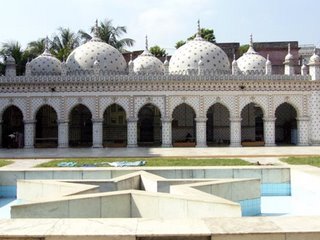
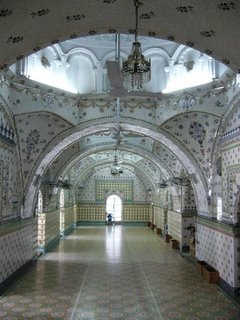

Armenian Church goes back to 1781. It was built during Dhaka's heydays when many European merchants came here looking for business and their fortunes. It is locally known as "khristan bari". Here are three pictures.
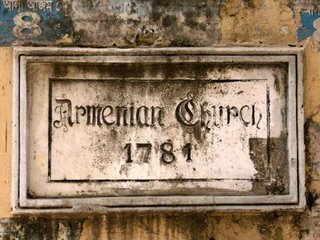


Ruplal House is a grand 19th century mansion built by Mr Ruplal, a businessman. Today it houses some businesses as well as Army folks.



Khan Mohammed Mridha's mosque dates back to 1706. It is built on a raised platform. On the bottom floor, below the mosque platform, are dorm rooms where students live. The third picture is the hallway connecting these rooms.
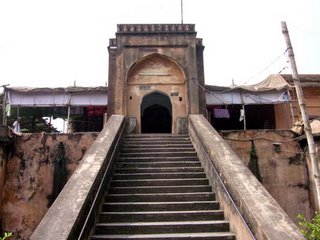

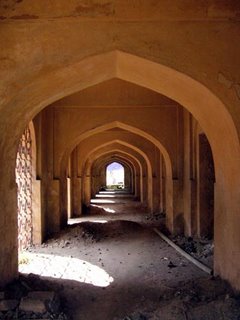
Here are some pictures of Shakhari Patti. Shakharis are (Hindu) craftsmen who make ornaments from Shakha (conch shells). They came here over 300 years ago. This area is known for the very long and narrow houses (the second picture shows one such narrow house.) The third picture shows an abandoned building with the trademark triple-arch that is common to old Shakhari Patti houses.
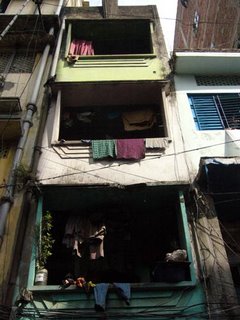


A picture of Lalbagh Fort, which was built in 1678 by Prince Azam, the third son of Aurangzeb.
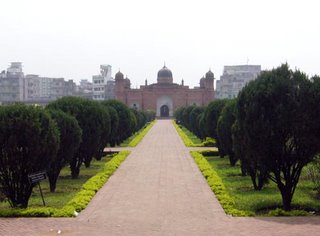
How can I not include the Pink Palace, aka Ahsan Manzil? Built in 1872 by Nawab Ahsanullah, renovated recently. I am not crazy about the color, but I am glad they put in the effort into renovation.

Tara Masjid in Bangsal was the most exquisitely building I found. Parts of it are 200+ years old, though it was renovated in 1987. Here are three pictures of it.



Armenian Church goes back to 1781. It was built during Dhaka's heydays when many European merchants came here looking for business and their fortunes. It is locally known as "khristan bari". Here are three pictures.



Ruplal House is a grand 19th century mansion built by Mr Ruplal, a businessman. Today it houses some businesses as well as Army folks.



Khan Mohammed Mridha's mosque dates back to 1706. It is built on a raised platform. On the bottom floor, below the mosque platform, are dorm rooms where students live. The third picture is the hallway connecting these rooms.



Here are some pictures of Shakhari Patti. Shakharis are (Hindu) craftsmen who make ornaments from Shakha (conch shells). They came here over 300 years ago. This area is known for the very long and narrow houses (the second picture shows one such narrow house.) The third picture shows an abandoned building with the trademark triple-arch that is common to old Shakhari Patti houses.



A picture of Lalbagh Fort, which was built in 1678 by Prince Azam, the third son of Aurangzeb.

How can I not include the Pink Palace, aka Ahsan Manzil? Built in 1872 by Nawab Ahsanullah, renovated recently. I am not crazy about the color, but I am glad they put in the effort into renovation.

Friday, November 10, 2006
Making of a Software Engineer
I wrote this article for the Daily Star on some skills that a fresh IT graduate, knowledgeable in technology but inexperienced as an engineer, will need to learn to become a professional engineer.
Tuesday, November 07, 2006
Dhamrai Metal Craft (Photos)
Dhamrai is famous for its handicraft work. It is about 25 km from Dhaka and takes between 1.5 to 2 hours by bus from Asad Gate. From the bus stop you take a rickshaw to Dhamrai Bazar.
Sukanta Vanik, who owns Sukanta's Dhamrai Metal Crafts. His family has worked in metalcraft for 200 years.

To make a metallic object of art, the worker starts with wax..
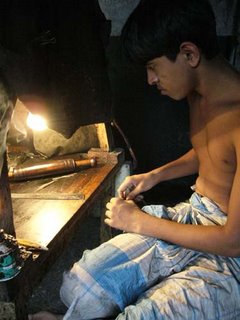
...which is painstakingly rolled and cut...
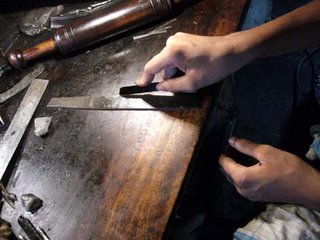
... to make a replica of the object

A worker then covers this with a special type of mud...

...so the wax replicas look like this.

These are baked in this oven which melts the wax and hardens the mud into a mold:

Finally molten metal is poured into the mold to make the finished product:


Some of the art can take 5-6 months of work. I saw an exquisite merry-go-round of horses, about a foot in diameter, priced at Tk. 18000.
I saw many types of craft around Dhamrai Bazar, such as making Dhols (drums).
Many thanks to my friend Zahed for being guide.
Sukanta Vanik, who owns Sukanta's Dhamrai Metal Crafts. His family has worked in metalcraft for 200 years.

To make a metallic object of art, the worker starts with wax..

...which is painstakingly rolled and cut...

... to make a replica of the object

A worker then covers this with a special type of mud...

...so the wax replicas look like this.

These are baked in this oven which melts the wax and hardens the mud into a mold:

Finally molten metal is poured into the mold to make the finished product:


Some of the art can take 5-6 months of work. I saw an exquisite merry-go-round of horses, about a foot in diameter, priced at Tk. 18000.
I saw many types of craft around Dhamrai Bazar, such as making Dhols (drums).
Many thanks to my friend Zahed for being guide.
Monday, November 06, 2006
Bicycles Available in Dhaka
Someone asked about bicycle availability in Dhaka. Basically there are two kinds: the traditional ones (Phoenix is a popular brand) and the newer Mt Bikes from China. Although I have not tried either in recent years, what I hear is that the Chinese Mt Bikes, meant for kids or leisure use, are flimsier than the traditional ones.
If you plan to bicycle a lot in Bangladeshi countryside you will need a sturdy Mt Bike. Your best bet is to bring one from abroad. They can be boxed and checked in as airline luggage (may be excess baggage?) We brought our (somewhat older) bikes from the US in our shipping container. Also get some basic tools and spare spokes and tubes. (My Schwinn recently broke 5 (!) spokes and I had a heck of a time getting it repaired here.)
There is also the Bangkok option. Several expats I know picked up a Mt Bike when they were in Bangkok, and checked it as luggage. You can get some good ones there, including a brand called Trek which seems really nice.
If you plan to bicycle a lot in Bangladeshi countryside you will need a sturdy Mt Bike. Your best bet is to bring one from abroad. They can be boxed and checked in as airline luggage (may be excess baggage?) We brought our (somewhat older) bikes from the US in our shipping container. Also get some basic tools and spare spokes and tubes. (My Schwinn recently broke 5 (!) spokes and I had a heck of a time getting it repaired here.)
There is also the Bangkok option. Several expats I know picked up a Mt Bike when they were in Bangkok, and checked it as luggage. You can get some good ones there, including a brand called Trek which seems really nice.
Sunday, November 05, 2006
Cow Talk in Old Dhaka
I went to old Dhaka to pick up hard-to-get bicycle parts, then chatted with some locals. Now that we are past Ramzan people's thoughts are on Korbani Eid (when an animal is sacrificed) coming up in two months. The Korbani markets (for buying the sacrificial animals) will begin in earnest in another month, but cow talk has already started in old Dhaka.
So what are popular animals, I asked. "Cows and Khasis, of course", was the answer, "and the rare BhuTTi cow occasionally." BhuTTI cow? (Is this guy pulling my leg?) "It is a small cow, looks very nice, only so high (his hand is at the knees). They fetch a premium price because they are so rare."
Inevitably, talk of prices. "Last year a cow sold for Tk 220,000." Wow, I said, that's pretty high. "It was a big cow," he said, "and beautiful. Very meaty. You could not feel one bone on any part of its body from the outside." How much meat would it yield? "250-300kg, easily." What was it fed? "Better food than humans! Sacks of corn and other good stuff." Who bought it? "Some local commissioner (politician). Used to be only Chittagong merchants could afford these expensive cows, but now there are rich politicians and merchants everywhere."
This Sumo cow had led quite the pampered life. "It had a room of its own. One person was there just to clean up after it all day." And the Dhakaiya finale: "The owner of this cow did not want it to be bitten by mosquitoes, so it slept under a mosquito net every night."
So what are popular animals, I asked. "Cows and Khasis, of course", was the answer, "and the rare BhuTTi cow occasionally." BhuTTI cow? (Is this guy pulling my leg?) "It is a small cow, looks very nice, only so high (his hand is at the knees). They fetch a premium price because they are so rare."
Inevitably, talk of prices. "Last year a cow sold for Tk 220,000." Wow, I said, that's pretty high. "It was a big cow," he said, "and beautiful. Very meaty. You could not feel one bone on any part of its body from the outside." How much meat would it yield? "250-300kg, easily." What was it fed? "Better food than humans! Sacks of corn and other good stuff." Who bought it? "Some local commissioner (politician). Used to be only Chittagong merchants could afford these expensive cows, but now there are rich politicians and merchants everywhere."
This Sumo cow had led quite the pampered life. "It had a room of its own. One person was there just to clean up after it all day." And the Dhakaiya finale: "The owner of this cow did not want it to be bitten by mosquitoes, so it slept under a mosquito net every night."
Saturday, November 04, 2006
Nosiman Revisited
In September I wrote about this ingenious home-grown people-mover, called a Nosiman (as Rajputro pointed out). I looked at another one yesterday. Built around a diesel irrigation pump, it can carry a dozen or more people around narrow, uncrowded village streets.
I had questions about the brakes and took a look. The brake pedal is at the front, bottom-right of the driver (with the criss-cross pattern).
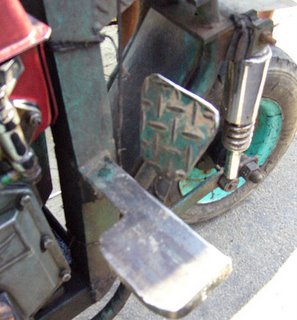
This pedal pulls on a rod connected to a kind of rubber sheet wrapped around the rear axle. When the brake is applied, this sheet tightens and slows down the vehicle.
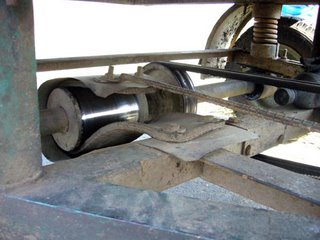
How well does it brake? Don't expect Bembo performance but, I heard, not too bad given the unsual design.
The vehicle appears totally locally designed (except for the motor of course.) Oh yeah, they cost Tk 40000 each and the driver earns around Tk 300 per day.
We also passed a rickshaw (!) fitted with one of these pumps. It was weird to see the rickshaw-wallah sitting on his seat doing nothing while the rickshaw moved at a good clip. Will take a closer look next time.
I had questions about the brakes and took a look. The brake pedal is at the front, bottom-right of the driver (with the criss-cross pattern).

This pedal pulls on a rod connected to a kind of rubber sheet wrapped around the rear axle. When the brake is applied, this sheet tightens and slows down the vehicle.

How well does it brake? Don't expect Bembo performance but, I heard, not too bad given the unsual design.
The vehicle appears totally locally designed (except for the motor of course.) Oh yeah, they cost Tk 40000 each and the driver earns around Tk 300 per day.
We also passed a rickshaw (!) fitted with one of these pumps. It was weird to see the rickshaw-wallah sitting on his seat doing nothing while the rickshaw moved at a good clip. Will take a closer look next time.
Friday, November 03, 2006
Subscribe to:
Comments (Atom)


